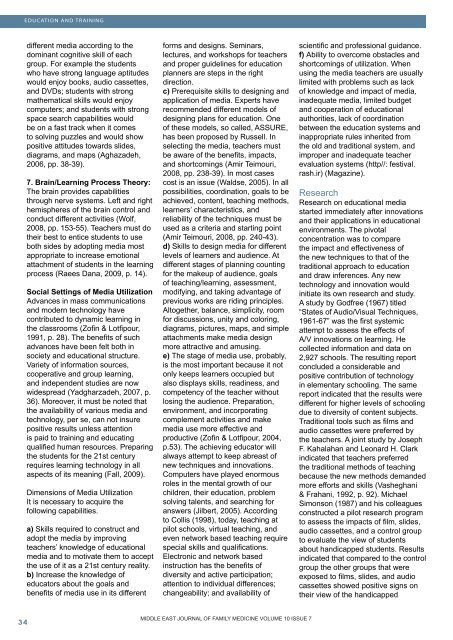full pdf of issue - Middle East Journal of Family Medicine
full pdf of issue - Middle East Journal of Family Medicine
full pdf of issue - Middle East Journal of Family Medicine
- No tags were found...
Create successful ePaper yourself
Turn your PDF publications into a flip-book with our unique Google optimized e-Paper software.
EDUCATION AND TRAININGdifferent media according to thedominant cognitive skill <strong>of</strong> eachgroup. For example the studentswho have strong language aptitudeswould enjoy books, audio cassettes,and DVDs; students with strongmathematical skills would enjoycomputers; and students with strongspace search capabilities wouldbe on a fast track when it comesto solving puzzles and would showpositive attitudes towards slides,diagrams, and maps (Aghazadeh,2006, pp. 38-39).7. Brain/Learning Process Theory:The brain provides capabilitiesthrough nerve systems. Left and righthemispheres <strong>of</strong> the brain control andconduct different activities (Wolf,2008, pp. 153-55). Teachers must dotheir best to entice students to useboth sides by adopting media mostappropriate to increase emotionalattachment <strong>of</strong> students in the learningprocess (Raees Dana, 2009, p. 14).Social Settings <strong>of</strong> Media UtilizationAdvances in mass communicationsand modern technology havecontributed to dynamic learning inthe classrooms (Z<strong>of</strong>in & Lotfipour,1991, p. 28). The benefits <strong>of</strong> suchadvances have been felt both insociety and educational structure.Variety <strong>of</strong> information sources,cooperative and group learning,and independent studies are nowwidespread (Yadgharzadeh, 2007, p.36). Moreover, it must be noted thatthe availability <strong>of</strong> various media andtechnology, per se, can not insurepositive results unless attentionis paid to training and educatingqualified human resources. Preparingthe students for the 21st centuryrequires learning technology in allaspects <strong>of</strong> its meaning (Fall, 2009).Dimensions <strong>of</strong> Media UtilizationIt is necessary to acquire thefollowing capabilities.a) Skills required to construct andadopt the media by improvingteachers’ knowledge <strong>of</strong> educationalmedia and to motivate them to acceptthe use <strong>of</strong> it as a 21st century reality.b) Increase the knowledge <strong>of</strong>educators about the goals andbenefits <strong>of</strong> media use in its differentforms and designs. Seminars,lectures, and workshops for teachersand proper guidelines for educationplanners are steps in the rightdirection.c) Prerequisite skills to designing andapplication <strong>of</strong> media. Experts haverecommended different models <strong>of</strong>designing plans for education. One<strong>of</strong> these models, so called, ASSURE,has been proposed by Russell. Inselecting the media, teachers mustbe aware <strong>of</strong> the benefits, impacts,and shortcomings (Amir Teimouri,2008, pp. 238-39). In most casescost is an <strong>issue</strong> (Waldse, 2005). In allpossibilities, coordination, goals to beachieved, content, teaching methods,learners’ characteristics, andreliability <strong>of</strong> the techniques must beused as a criteria and starting point(Amir Teimouri, 2008, pp. 240-43).d) Skills to design media for differentlevels <strong>of</strong> learners and audience. Atdifferent stages <strong>of</strong> planning countingfor the makeup <strong>of</strong> audience, goals<strong>of</strong> teaching/learning, assessment,modifying, and taking advantage <strong>of</strong>previous works are riding principles.Altogether, balance, simplicity, roomfor discussions, unity and coloring,diagrams, pictures, maps, and simpleattachments make media designmore attractive and amusing.e) The stage <strong>of</strong> media use, probably,is the most important because it notonly keeps learners occupied butalso displays skills, readiness, andcompetency <strong>of</strong> the teacher withoutlosing the audience. Preparation,environment, and incorporatingcomplement activities and makemedia use more effective andproductive (Z<strong>of</strong>in & Lotfipour, 2004,p.53). The achieving educator willalways attempt to keep abreast <strong>of</strong>new techniques and innovations.Computers have played enormousroles in the mental growth <strong>of</strong> ourchildren, their education, problemsolving talents, and searching foranswers (Jilbert, 2005). Accordingto Collis (1998), today, teaching atpilot schools, virtual teaching, andeven network based teaching requirespecial skills and qualifications.Electronic and network basedinstruction has the benefits <strong>of</strong>diversity and active participation;attention to individual differences;changeability; and availability <strong>of</strong>scientific and pr<strong>of</strong>essional guidance.f) Ability to overcome obstacles andshortcomings <strong>of</strong> utilization. Whenusing the media teachers are usuallylimited with problems such as lack<strong>of</strong> knowledge and impact <strong>of</strong> media,inadequate media, limited budgetand cooperation <strong>of</strong> educationalauthorities, lack <strong>of</strong> coordinationbetween the education systems andinappropriate rules inherited fromthe old and traditional system, andimproper and inadequate teacherevaluation systems (http//: festival.rash.ir) (Magazine).ResearchResearch on educational mediastarted immediately after innovationsand their applications in educationalenvironments. The pivotalconcentration was to comparethe impact and effectiveness <strong>of</strong>the new techniques to that <strong>of</strong> thetraditional approach to educationand draw inferences. Any newtechnology and innovation wouldinitiate its own research and study.A study by Godfree (1967) titled“States <strong>of</strong> Audio/Visual Techniques,1961-67” was the first systemicattempt to assess the effects <strong>of</strong>A/V innovations on learning. Hecollected information and data on2,927 schools. The resulting reportconcluded a considerable andpositive contribution <strong>of</strong> technologyin elementary schooling. The samereport indicated that the results weredifferent for higher levels <strong>of</strong> schoolingdue to diversity <strong>of</strong> content subjects.Traditional tools such as films andaudio cassettes were preferred bythe teachers. A joint study by JosephF. Kahalahan and Leonard H. Clarkindicated that teachers preferredthe traditional methods <strong>of</strong> teachingbecause the new methods demandedmore efforts and skills (Vasheghani& Frahani, 1992, p. 92). MichaelSimonson (1987) and his colleaguesconstructed a pilot research programto assess the impacts <strong>of</strong> film, slides,audio cassettes, and a control groupto evaluate the view <strong>of</strong> studentsabout handicapped students. Resultsindicated that compared to the controlgroup the other groups that wereexposed to films, slides, and audiocassettes showed positive signs ontheir view <strong>of</strong> the handicapped34 MIDDLE EAST JOURNAL OF FAMILY MEDICINE VOLUME 10 ISSUE 7MIDDLE EAST JOURNAL OF FAMILY MEDICINE • VOLUME 7, ISSUE 10
















